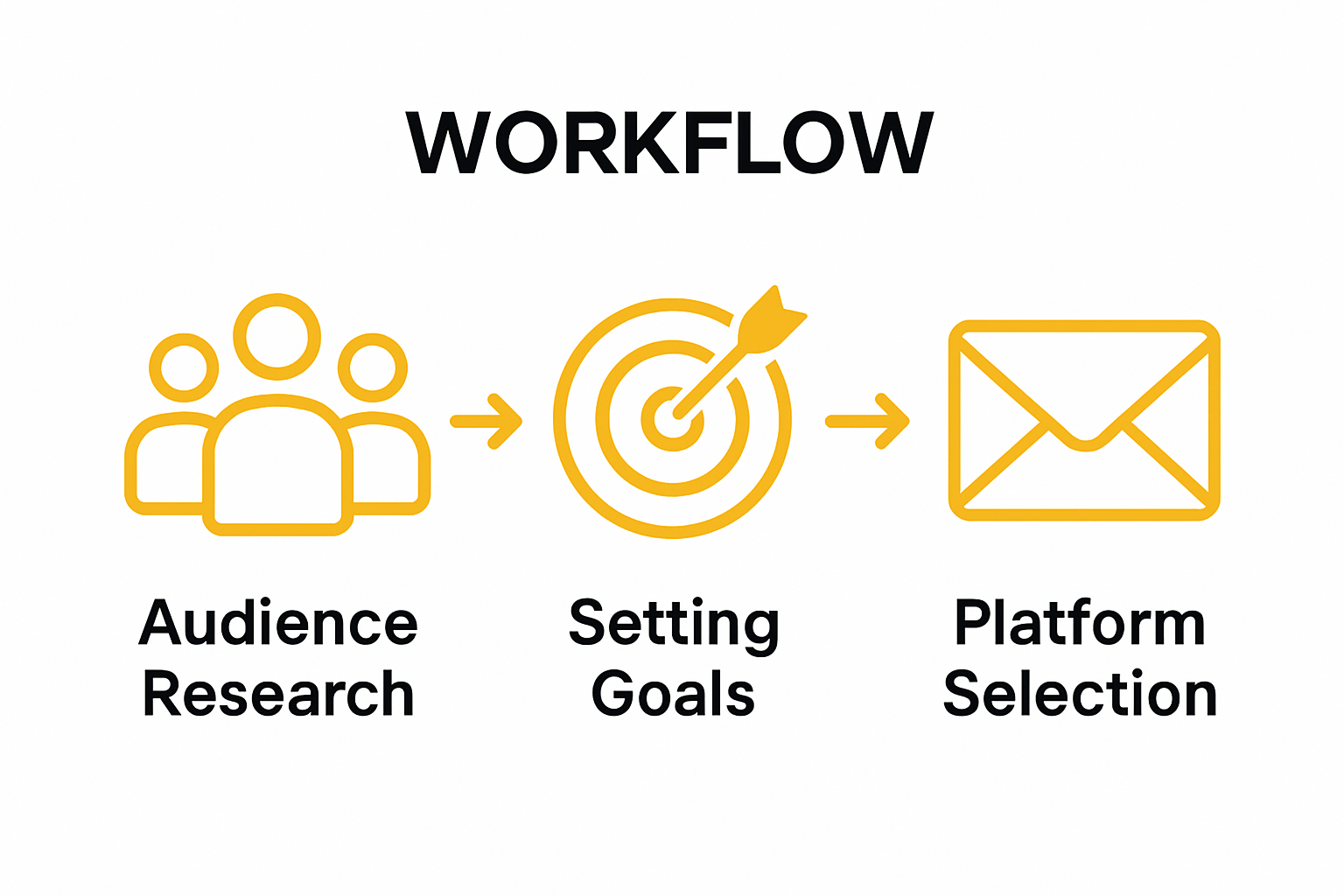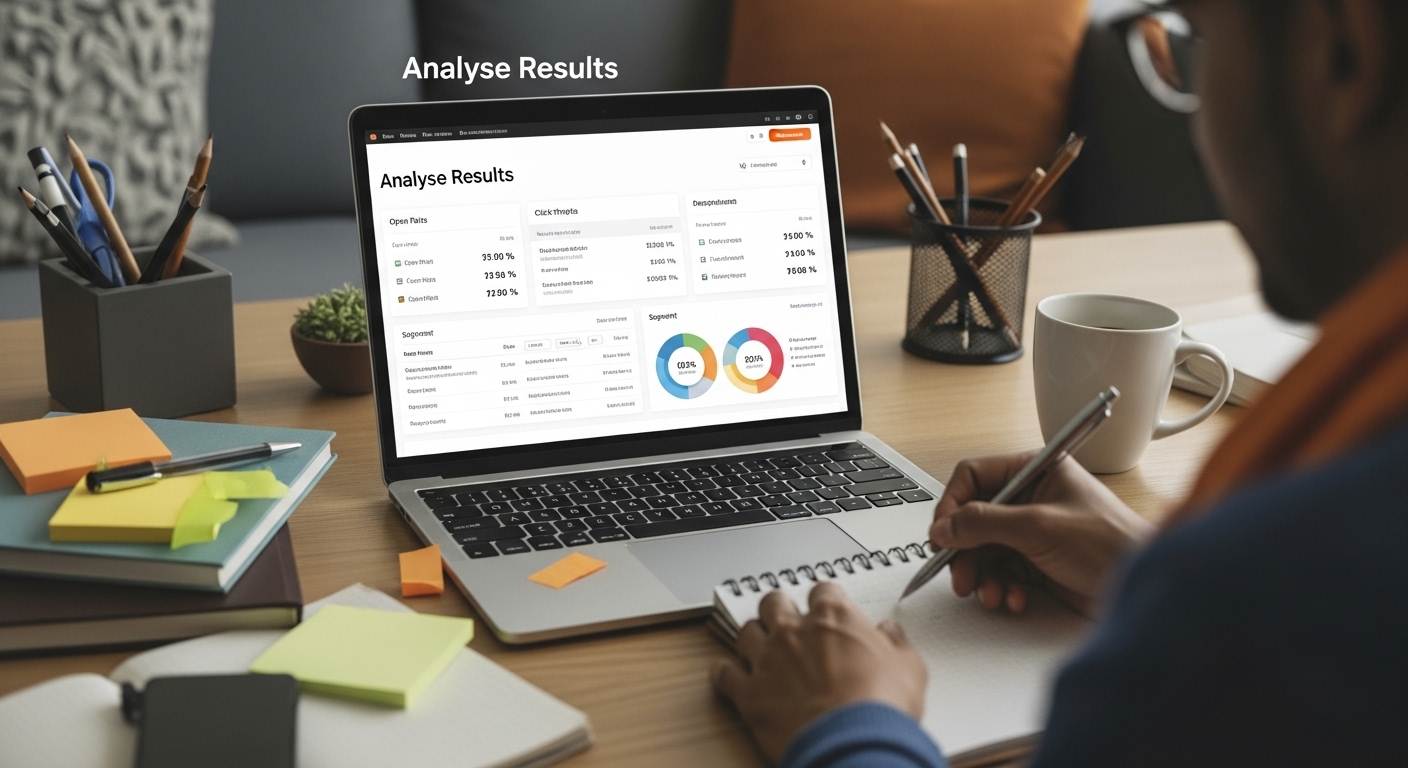Email Marketing Strategy Guide: Boost Engagement & Sales
- Eddie The Chef

- Sep 11
- 10 min read

Building a winning email marketing campaign in Australia is more than just hitting send and hoping for the best. Around 78 percent of Australian marketers still rank email as their most effective digital channel, even though inboxes are fuller than ever. Most businesses get stuck sending out the same old newsletters and miss out on real results because they skip the steps that actually matter.
Table of Contents
Quick Summary
Key Point | Explanation |
1. Define Your Target Audience Clearly | Understand audience demographics and motivations for effective email content. |
2. Set SMART Marketing Goals | Use SMART criteria to ensure goals are clear and achievable for email campaigns. |
3. Choose the Right Platform | Select an email platform that meets your business needs and integrates well with existing systems. |
4. Craft Engaging Email Content | Focus on compelling subject lines and personalized content that speaks directly to the audience. |
5. Regularly Monitor Campaign Performance | Track metrics post-launch to assess effectiveness and adjust strategies based on insights. |
Step 1: Define Your Target Audience
Creating an effective email marketing strategy starts with knowing exactly who will receive your messages. Your target audience is the foundation of successful communication, determining how you craft, design, and deliver your email campaigns. Understanding your audience goes beyond basic demographics - it requires deep insights into their motivations, challenges, and preferences.
To define your target audience, begin by examining your existing customer database. Look for common characteristics such as age, location, purchasing history, and engagement patterns. The goal is to create a comprehensive profile that represents your ideal customer. Start by segmenting your current customers into distinct groups based on shared attributes. For Australian businesses, this might mean categorising customers by industry, regional location, or specific service needs.
Practical audience research involves multiple approaches. Consider conducting surveys, analysing website analytics, and reviewing past customer interactions. Tools like Google Analytics can provide valuable demographic insights about your website visitors. Pay attention to metrics like age range, geographic location, device usage, and browsing behaviour. These details help you understand who is already interested in your products or services.
As you develop your audience profile, create a detailed persona representing your typical customer. This persona should include not just statistical data, but also potential pain points, professional goals, and communication preferences. For instance, a local Gippsland automotive service might discover their target audience includes tradespeople between 35-55 years old, who value direct communication and practical solutions.
Remember that your target audience is not static. Regularly review and update your audience definition as market conditions change. Your email marketing strategy should remain flexible, allowing you to refine your approach based on ongoing customer feedback and engagement metrics.
Below is a checklist table summarising key verification steps for Step 1: Define Your Target Audience, ensuring you have covered every necessary aspect before moving to the next stage.
Checklist Item | Description |
Compiled customer demographic data | Gathered comprehensive data on age, location, and behaviours |
Created detailed customer personas | Developed 1-2 typical personas with motivations and pain points |
Identified communication channels and preferences | Noted favourite channels and preferred communication styles |
Established baseline understanding of motivations | Understood customer needs and reasons for engagement |
Verification checklist for completing this step:
Compiled comprehensive customer demographic data
Created 1-2 detailed customer personas
Identified key communication channels and preferences
Established baseline understanding of customer motivations
Step 2: Set Clear Marketing Goals
After defining your target audience, the next critical step in your email marketing strategy is establishing clear, purposeful goals that drive meaningful business outcomes. Goals transform your email marketing from a random communication activity into a strategic business tool that delivers measurable results.
Begin by identifying specific objectives that align with your broader business strategy. Email marketing goals typically fall into three primary categories: lead generation, customer retention, and sales conversion. For a regional Australian business, this might mean increasing online bookings, encouraging repeat purchases, or nurturing potential client relationships. The key is selecting goals that are not just aspirational but quantifiably achievable.
Utilise the SMART framework to crystallise your objectives. Each goal should be Specific (clearly defined), Measurable (trackable with concrete metrics), Achievable (realistic given your resources), Relevant (aligned with business needs), and Time-bound (with a clear deadline). For instance, instead of a vague goal like “increase sales,” a SMART goal would be “Generate 15% more online service bookings within the next quarter through targeted email campaigns.”
Consider implementing specific tracking mechanisms to monitor your progress. Business Victoria’s digital strategy guidelines recommend using analytics tools that provide comprehensive insights into email campaign performance. Platforms like Google Analytics and email marketing software can help you track open rates, click-through rates, conversion rates, and other critical metrics that demonstrate goal achievement.
Remember that goals are not static. As your business evolves and market conditions change, your email marketing objectives should adapt. Schedule quarterly reviews to assess your progress, recalibrate strategies, and ensure your email marketing remains responsive to emerging business opportunities.
Verification checklist for completing this step:
Documented 2-3 specific, measurable email marketing goals
Aligned goals with overall business strategy
Established baseline metrics for tracking performance
Created a timeline for goal achievement and review
Step 3: Choose the Right Email Marketing Platform
Selecting an appropriate email marketing platform is crucial for transforming your strategic vision into successful digital communication. Your chosen platform will become the central hub for managing contacts, designing campaigns, tracking performance, and executing your email marketing strategy with precision and efficiency.
The ideal platform should seamlessly integrate with your existing business systems and provide robust features tailored to your specific marketing objectives. Begin by evaluating platforms that offer user-friendly interfaces, comprehensive automation capabilities, and detailed analytics. Consider your business size, technical expertise, and budget when making this critical decision. Regional Australian businesses typically benefit from platforms that provide straightforward setup, responsive customer support, and scalable pricing models.
Key considerations include email template design flexibility, segmentation capabilities, and integration potential with customer relationship management (CRM) systems. Look for platforms that allow you to create personalised email experiences without requiring advanced technical skills. Some platforms offer drag-and-drop editors, pre-designed templates, and intuitive workflow builders that make campaign creation accessible for businesses of all sizes.
Business Victoria’s digital strategy resources recommend evaluating platforms based on specific business needs. Popular options like Mailchimp, Klaviyo, and ActiveCampaign offer different strengths. Mailchimp works well for small businesses with simple needs, while Klaviyo provides advanced segmentation for more complex marketing strategies. ActiveCampaign offers robust automation features suitable for businesses seeking sophisticated customer journey mapping.
To help you compare and select an email marketing platform, the following table highlights the core features and suitability of the main options discussed in the article.
Platform | Best For | Notable Features | Pricing/Scalability |
Mailchimp | Small businesses, beginners | Easy setup, drag-and-drop templates | Entry-level plans, scalable |
Klaviyo | Advanced segmentation needs | Detailed audience segmentation | Flexible plans, suited for growth |
ActiveCampaign | Automation, customer journeys | Robust automation, CRM integration | Tiered pricing, suitable for scale |
Prioritise platforms that provide comprehensive reporting tools.

These analytics help you understand campaign performance, track engagement metrics, and make data-driven improvements. Look for features like open rates, click-through tracking, conversion monitoring, and audience segmentation capabilities.
Verification checklist for completing this step:
Compared 3-4 email marketing platforms
Assessed platform features against business requirements
Evaluated pricing and scalability
Selected platform aligned with marketing goals
Step 4: Design Engaging Email Content
Creating compelling email content is the heart of successful email marketing, transforming your strategic goals into messages that capture attention and drive action. Your email content must speak directly to your audience’s needs, interests, and pain points, turning each communication into an opportunity for meaningful connection.
Start by crafting a powerful subject line that immediately signals value to your recipients. Think of your subject line as the front door to your email - it must be inviting, clear, and intriguing enough to encourage opening. Avoid generic phrases and instead use language that creates curiosity or addresses a specific benefit. For instance, instead of “Monthly Newsletter,” try “Exclusive Gippsland Business Growth Strategies Revealed.”
Explore more about content marketing strategies that can enhance your email communication. The body of your email should maintain the promise made in the subject line, delivering concise, valuable content that speaks directly to your target audience. Use a conversational tone that feels personal and authentic. Break up text with short paragraphs, compelling visuals, and clear calls to action that guide readers toward the desired outcome.
Personalisation is crucial in modern email marketing. Go beyond simply inserting a recipient’s name by segmenting your audience and tailoring content to specific groups. A local automotive business might create different email content for tradespeople versus weekend car enthusiasts. Relevance drives engagement more effectively than generic messaging. Incorporate dynamic content that adapts based on the recipient’s previous interactions, purchasing history, or demonstrated interests.
Technical considerations are equally important. Ensure your email design is mobile-responsive, as most people now read emails on smartphones. Use clean, readable fonts, strategic use of white space, and visually appealing design elements that align with your brand identity. Test your emails across different devices and email clients to guarantee a consistent experience.
Verification checklist for completing this step:
Developed compelling, audience-specific email content
Created engaging subject lines
Designed mobile-responsive email templates
Implemented personalisation strategies
Step 5: Execute Your Campaign and Monitor Performance
Executing your email marketing campaign marks the transition from strategic planning to real-world implementation. This critical stage transforms your carefully crafted plan into actionable communication that connects directly with your target audience. The success of your campaign depends not just on sending emails, but on methodically tracking and interpreting their performance.
Before launching, conduct a final comprehensive review of your email content, ensuring all elements align with your predefined goals. Check technical aspects like email formatting, mobile responsiveness, and link functionality. Timing is crucial - select optimal sending times based on your audience’s typical engagement patterns. For regional Australian businesses, this might mean avoiding sending emails during typical work hours or late evening periods when recipients are less likely to engage.
Explore our detailed email marketing insights to enhance your campaign strategy. Performance monitoring begins immediately after campaign launch. Utilise your email marketing platform’s built-in analytics to track key metrics such as open rates, click-through rates, conversion rates, and unsubscribe rates. These indicators provide immediate insights into how your audience receives and interacts with your content.
According to Victoria’s digital performance measurement guidelines, collecting and analyzing data is fundamental to improving future campaigns. Look beyond surface-level metrics to understand deeper engagement patterns. Which segments of your audience are most responsive? What type of content generates the highest interaction? Are there specific times or days when your emails perform better?
Be prepared to make real-time adjustments. If initial performance metrics suggest low engagement, consider rapid iterations. This might involve tweaking subject lines, adjusting email design, or refining your audience segmentation. Successful email marketing is an iterative process of continuous improvement, where each campaign provides valuable learning opportunities.
Verification checklist for completing this step:
Launched email campaign across selected platforms
Implemented comprehensive performance tracking
Analyzed initial engagement metrics
Prepared strategy for potential campaign adjustments
Step 6: Analyse Results and Optimise Future Campaigns
Analysing your email marketing campaign results transforms raw data into strategic insights that fuel continuous improvement. This crucial step is where successful marketers distinguish themselves by turning performance metrics into actionable intelligence. Think of your campaign results as a detailed roadmap, revealing precisely what resonates with your audience and where opportunities for enhancement exist.
Begin by systematically reviewing comprehensive performance metrics. Look beyond surface-level statistics like open rates and dive deeper into engagement indicators. Which segments of your audience showed the most interaction? Compare performance across different customer groups, examining metrics such as click-through rates, conversion rates, and time spent reading. Pay special attention to which content types generated the most meaningful responses.
Learn more about strategic marketing insights to complement your email analysis. Research from RMIT University highlights the significance of understanding how design elements influence consumer responses. Conduct A/B testing to validate your insights, experimenting with different subject lines, email designs, send times, and content approaches. This methodical approach allows you to incrementally refine your email marketing strategy.
Optimisation is an ongoing process requiring both analytical thinking and creative problem solving. If certain email segments underperformed, investigate potential reasons. Was the content misaligned with audience expectations? Did technical issues prevent proper delivery? Did the timing of your email campaign miss optimal engagement windows? Each campaign provides valuable learning opportunities to enhance future communication strategies.
Develop a systematic approach to campaign improvement.

Create a dedicated performance review document that tracks key metrics across campaigns, allowing you to identify long-term trends and patterns. This historical data becomes an invaluable resource for making informed strategic decisions about future email marketing efforts.
Verification checklist for completing this step:
Completed comprehensive campaign performance analysis
Identified key strengths and improvement areas
Documented insights for future campaign refinement
Prepared initial optimization strategy
Struggling to Turn Email Strategy into Real Engagement?
Are you finding that despite defining your audience, setting goals, and building campaigns, your email marketing is still falling flat or not converting to real sales? It is common for regional Australian businesses to feel unsure about optimising every step, from content to execution. You are not alone — many local enterprises are held back by lack of time, technical know-how, or strategy to get measurable results from their campaigns. That is where we come in. At Marketing Recipes Australia, we specialise in bridging the gap between insightful marketing guides and hands-on, results-driven execution. Our team knows how to translate detailed audience research, SMART goal setting, and creative content into customer connections that boost engagement and sales.

Ready to finally see your efforts pay off? Access our complete suite of digital marketing solutions designed for regional business owners who want more than just theory. If you are looking for campaign management, video content to support your emails, or strategic consulting built just for local markets, our kitchen of services delivers. Discover how your business can benefit from expert support and practical action — reach out to Marketing Recipes Australia now and take the next step towards lasting growth.
Frequently Asked Questions
What is the first step in creating an email marketing strategy?
Defining your target audience is the first step in building an effective email marketing strategy. This involves understanding their demographics, motivations, preferences, and pain points.
How can I set measurable goals for my email marketing?
Utilise the SMART framework to set specific, measurable, achievable, relevant, and time-bound goals that align with your broader business strategy, such as increasing online bookings or improving customer retention rates.
What should I consider when choosing an email marketing platform?
When selecting an email marketing platform, consider features such as user-friendly interfaces, automation capabilities, integration with existing systems, scalability, and reporting tools to track campaign performance.
How can I analyse the performance of my email marketing campaigns?
You can analyse performance by reviewing key metrics such as open rates, click-through rates, conversion rates, and unsubscribe rates. Tools within your email marketing platform can provide detailed insights for continuous improvement.
Recommended
Comments